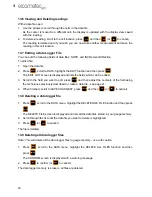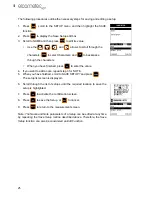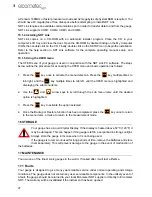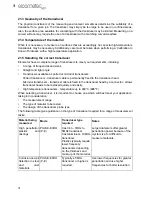
33
en
22 CONDITION AND PREPARATION OF SURFACES
The shape and roughness of the test surface are of paramount importance when carrying out
ultrasonic thickness testing. Rough, uneven surfaces may limit the penetration of ultrasound
through the material, and result in unstable, and therefore unreliable, measurements.
The surface being measured should be clean, and free of any small particles, rust, or scale. The
presence of such obstructions will prevent the transducer from seating properly against the surface.
Often, a wire brush or scraper will be helpful in cleaning surfaces. In more extreme cases, rotary
sanders or grinding wheels may be used, though care must be taken to prevent surface gouging,
which will inhibit proper transducer coupling.
Extremely rough surfaces, such as the pebble-like finish of some cast iron, will prove most difficult
to measure. These kinds of surfaces act on the sound beam like frosted glass acts on light, the
beam becomes diffused and scattered in all directions.
In addition to posing obstacles to measurement, rough surfaces contribute to excessive wear of the
transducer, particularly in situations where the transducer is ‘scrubbed’ along the surface.
23 APPLICATION NOTES
23.1 Searching for small defects
Dual element delay line transducers are especially useful in searching for small defects. In the
pulse-echo mode with high amplifier gain, very small defects can be measured.
This is very useful during inspection of cylinder walls and when porting heads. The dual element
style transducer will find porosity pockets and any potential defects in the cylinders and head ports
prior to boring or porting.
23.2 Measuring tubing
When measuring a piece of pipe to determine the thickness of the pipe wall, orientation of the
transducers is important.
If the diameter of the pipe is larger than approximately 100 mm (4”), measurements should be made
with the transducer oriented so that the gap in the wearface is perpendicular (at right angles) to the
long axis of the pipe.
If the diameter of the pipe is small, two measurements should be performed, one with the wearface
gap perpendicular to the long axis of the pipe, another with the gap parallel to the long axis of the
pipe - see illustration. The smaller of the two displayed values should then be taken as the thickness
at that point.
23.3 Measuring hot surfaces
The velocity of sound through a material depends upon the temperature of the material. As
materials heat up, the velocity of sound in the material decreases. In most applications with surface
temperatures less than approximately 100°C (~200°F), no special procedures are required. At
Perpendicular
Parallel





































